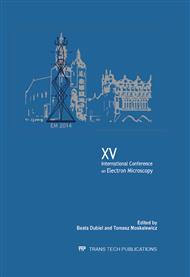p.65
p.73
p.81
p.87
p.93
p.101
p.107
p.113
p.119
Electron Microscopy Characterization of Friction Stir Welded 5083-H111 and 7075-T651 Aluminum Alloys
Abstract:
The microstructural characterization of butt friction stir welds of two different wrought aluminum alloys (work-hardened and heat treated) were studied. The detailed studies on the FSW process of dissimilar Al alloys are limited. In particular, the weld microstructure requires deeper characterization to better understand the phenomena occurring during mixing of dissimilar alloys.The characterization of friction stir welds was performed by scanning electron microscopy (an energy dispersive spectroscopy and an electron backscattered diffraction) and transmission electron microscopy. The dissimilar weld microstructure is complex, resembling a vortex-like structure. The microstructure of weld was highly asymmetrical with regard to the weld centerline. The research revealed a change in grain size in particular areas of the stirred zone. Recrystallization in the stirredzone occurred in particular areas in an irregular manner.
Info:
Periodical:
Pages:
93-99
Citation:
Online since:
June 2015
Authors:
Keywords:
Price:
Сopyright:
© 2015 Trans Tech Publications Ltd. All Rights Reserved
Share:
Citation:


